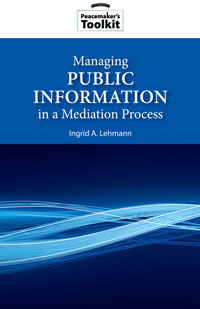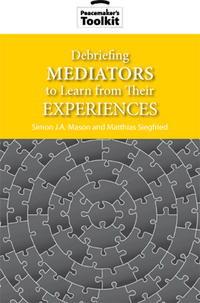USIP Mediation Resources
Crossposting from Craig Zelizer's P&CDN:
The U.S. Institute of Peace introduces The Peacemaker's Toolkit, a new series of handbooks for practitioners and educators about the art of mediation available online for free! Each handbook focuses on a particular facet of the mediator's trade, distilling practical guidance from a wealth of experience and expertise. Slim enough to fit into a pocket but packed with ideas, options and examples, the handbooks lay out the key steps to success. Five handbooks have now been published, focusing on relevant subjects such as how to manage a mediation process, debrief mediators and manage public information during a mediation process. All are available online and in print -- and all are free.
Current Handbooks Include:
 Managing a Mediation Process
Managing a Mediation Process
August 2008view-data-field-publication-date-value""> | Practitioner Tool by David R. Smock
and Amy L. Smith Managing a Mediaiton Process is
the first handbook of the Peacemaker’s Toolkit series. This handbook
provides a methodology for mediating interstate and intrastate
conflicts. Each of the six chapters covers a different step in the
process, identifying what needs to be done at that step and how best to
accomplish it. By consolidating the practical wisdom of managing a
mediation process into an easily digestible format, Managing a
Mediation Process is designed to help mediators identify areas where
they may need more research or preparation, as well as develop options
and strategies relevant to the particular case on which they are
working. | a Mediation Process');"'>Download the handbook (PDF/856 KB)- Access the Managing a Mediation Process Web Handbook
The web version of Managing a Mediation Process
allows readers not only to view and search the full text of the
handbook but also to link instantly to more detailed resources,
including analyses, educational materials, tools, and news.
- Access the Managing a Mediation Process Web Handbook
 Managing Public Information in a Mediation Process
Managing Public Information in a Mediation Process
February
2009 | Practitioner
Tool by Ingrid A. Lehmann
The second handbook of the Peacemaker’s Toolkit series, Managing
Public Information in a Mediation Process helps mediators identify
and develop the resources and strategies they need to reach these
audiences. It highlights essential information taks and functions,
discusses key challenges and opportunities, and provides expert guidance
on effective approaches. Examples from past mediations illustrate how
various strategies have played out in practice.
Download
the Handbook (PDF/1.31 MB)- Integrating Internal Displacement in Peace Processes and Agreements
 Displacement Handbook cover. (Image: U.S. Institute of Peace)" vspace="5" width="87" align="right" border="1" height="132" hspace="5"">
Displacement Handbook cover. (Image: U.S. Institute of Peace)" vspace="5" width="87" align="right" border="1" height="132" hspace="5"">
April
2010 | Practitioner
Tool by Gerard McHugh
Leading experts on mediation and the plight of internally displaced
persons (IDPs) collaborated to produce this handbook, which gives
mediators the tools they need to incorporate IDPs' concerns into peace
processes and agreements. Achieving such integration will not only
safeguard the rights and interests of IDPs as stakeholders in a peace
process but will also help mediators reach a negotiated and lasting
settlement for all the parties involved in a conflict.
Download
the Handbook (PDF/2.03 MB)
- Debreifing Mediators to Learn from Their Experiences

April
2010 | Practitioner
Tool by Simon J. A. Mason and Matthias Siegfried
This handbook examines interviews conducted with mediators to learn
lessons about their mediation “method.” These methodological debriefings
are typically conducted by individuals who have not been directly
involved in the mediator’s work but who want to learn the mediator’s
perspective on what was done and why it was done. This handbook enhances
the practice of mediation by showing how lessons from individual
mediators can be identified and made available both to their
organizations and to a wider practitioner audience. It also gives
guidance to staff debriefing mediators who are or have been directly
involved in peace negotiations. | Download
the Handbook (PDF/1.54 MB)
- Timing Mediation Initiatives
 Mediation Handbook cover. (Image: U.S. Institute of Peace)" vspace="5" width="87" align="right" border="1" height="132" hspace="5"">
Mediation Handbook cover. (Image: U.S. Institute of Peace)" vspace="5" width="87" align="right" border="1" height="132" hspace="5"">
April
2010 | Practitioner Tool
by I. William Zartman and Alvaro de SotoA mediation initiative cannot be launched at just any time if it is to succeed. The conflict must be ripe for the initiation of negotiation. Parties resolve their conflict only when forced to do so-when each
party’s efforts to achieve a unilaterally satisfactory result are
blocked and the parties feel trapped in an uncomfortable and costly
predicament. This toolkit lays out five steps mediators can take to
assess whether a stalemate exists; interpret the parties’ perception of
where they stand in the conflict; and encourage a ripe moment for
mediation. | Download
the Handbook (PDF/1.28 MB)
http://www.usip.org/resources/peacemaker-s-toolkit
The series is being designed for experienced mediation practitioners and negotiators, but will be a valuable resource for students and policymakers. Future handbooks include: Negotiating with Terrorists,
Dealing with the Impact of an International Tribunal on a Peace
Process; and Coordinating Track I and II Efforts.
Share Twitter
Tags:
Replies to This Discussion
About
@ADRHub Tweets
© 2025 Created by ADRhub.com - Creighton NCR.
Powered by
![]()